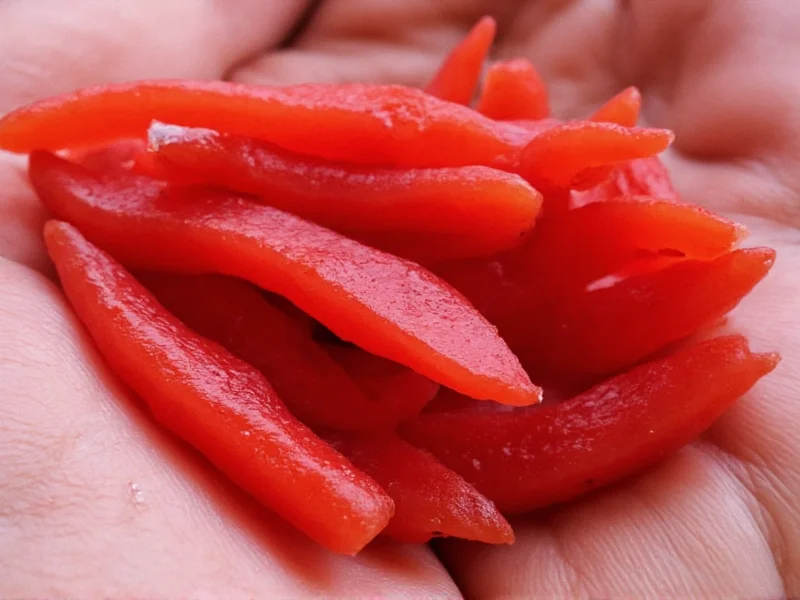Understanding proper chamoy storage prevents waste and ensures you enjoy this popular Mexican condiment at its best. Chamoy's unique sweet-sour-spicy flavor profile makes it a favorite for fruit snacks, cocktails, and culinary creations, but its storage requirements often confuse consumers.
Chamoy Composition and Its Impact on Storage
Chamoy's storage needs depend primarily on its ingredients and preservation methods. Traditional chamoy combines:
- Tamarind pulp or other fruit bases
- Sugar (often 50% or higher concentration)
- Vinegar or citrus juice
- Chili peppers
- Salt
- Preservatives (in commercial varieties)
The high sugar and acid content creates an environment where bacteria struggle to grow, making unopened commercial chamoy shelf-stable. Sugar acts as a natural preservative by binding water molecules, while vinegar's acidity creates unfavorable conditions for microbial growth.
Commercial Chamoy Storage Guidelines
Major chamoy brands follow similar storage protocols, though always check your specific product's label for manufacturer recommendations.
| Storage Condition | Unopened Shelf Life | Opened Shelf Life | Quality Notes |
|---|---|---|---|
| Pantry (unopened) | 12-18 months | N/A | Maintains optimal flavor and texture |
| Refrigerated (unopened) | 18-24 months | N/A | Slightly extends shelf life |
| Pantry (opened) | N/A | 1-2 months | Quality degrades faster; risk of spoilage increases |
| Refrigerated (opened) | N/A | 6-9 months | Maintains flavor, texture, and safety |
Refrigeration after opening significantly extends chamoy's usability while preserving its complex flavor profile. The cold temperature slows oxidation and prevents potential mold growth that could occur in warmer environments.
Homemade Chamoy Storage Requirements
Unlike commercial products, homemade chamoy almost always requires refrigeration from the moment it's made. Without commercial preservatives, the natural ingredients begin deteriorating more quickly.
Most homemade chamoy recipes last 2-4 weeks in the refrigerator when stored in airtight containers. Some variations with higher sugar concentrations might reach 6 weeks, but never assume safety beyond 4 weeks without specific food safety testing.
Signs Your Chamoy Has Spoiled
Even with proper storage, chamoy can eventually spoil. Watch for these warning signs that indicate your chamoy has gone bad:
- Visible mold growth - any fuzzy spots or discoloration
- Off smells - sour or fermented odors beyond its normal tangy profile
- Texture changes - separation that doesn't remix, sliminess, or crystallization
- Color changes - significant darkening or fading from original hue
- Bulging lid - indicates gas production from microbial activity
If you notice any of these signs, discard the chamoy immediately. Consuming spoiled chamoy can cause foodborne illness despite its high acidity.
Best Practices for Chamoy Storage
Follow these expert storage tips to maximize your chamoy's shelf life and quality:
- Always refrigerate after opening - this applies to nearly all commercial chamoy products
- Use clean utensils - prevent contamination by never dipping used utensils into the bottle
- Keep the lid tightly sealed - minimize air exposure which accelerates spoilage
- Store away from heat sources - even unopened bottles degrade faster near stoves or in direct sunlight
- Check expiration dates - though often conservative, they provide a safety baseline
- Consider freezing for long-term storage - frozen chamoy maintains quality for 12-18 months
Special Considerations for Different Chamoy Types
Not all chamoy products share identical storage requirements. Understanding these variations helps you make informed decisions:
- Tamarind-based chamoy - typically more stable due to tamarind's natural preservative qualities
- Fruit-forward chamoy (mango, apricot) - may require stricter refrigeration due to higher water content
- Low-sugar or "natural" varieties - often need refrigeration even before opening
- Chamoy with fresh ingredients - products containing fresh chilies or fruit pieces need immediate refrigeration
When in doubt about a specific product, refrigeration provides the safest option. The slight texture change that sometimes occurs when refrigerating certain chamoy varieties (it may thicken slightly) reverses at room temperature within 30 minutes.











 浙公网安备
33010002000092号
浙公网安备
33010002000092号 浙B2-20120091-4
浙B2-20120091-4